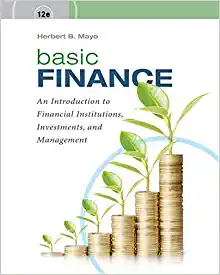Question
1.Joe now has $600.How much would he have after 5 years if he leaves it invested at 6.0% with annual compounding? a.$555.00 b.$734.66 c.$484.65 d.$802.94
1.Joe now has $600.How much would he have after 5 years if he leaves it invested at 6.0% with annual compounding?
a.$555.00
b.$734.66
c.$484.65
d.$802.94
e.$897.44
2.How much would $20,000 due in 20 years be worth today if the discount rate is 9.0%?
a.$168,132.32
b.$295,876.44
c.$3,568.61
d.$5,352.93
e.$3,879.78
3.Suppose the U.S. Treasury offers to sell you a bond for $747.25.No payments will be made until the bond matures 5 years from now, at which time it will be redeemed for $1,000.What interest rate would you earn if you bought this bond at the offer price?
a.4.37%
b.4.86%
c.5.40%
d.6.00%
e.6.60%
4.Assume that interest rates on 10-year Treasury and corporate bonds are as follows:Treasury Bond = 7.72%; AAA = 8.72%; A = 9.64%; and BBB = 10.18%.The difference in these rates is primarily caused by:
a.Maturity rate differences..
b.Default risk differences.
c.Inflation differences.
d.Real risk free rate differences.
5.Suppose 1-year Treasury bills currently yield 7.00% and the current and future inflation rate is expected to be constant at 3.2% per year.What is the real risk-free rate of return, r*?
a.4.19%
b.3.80%
c.4.40%
d.4.62%
6.Suppose the interest rate on a 1-year T-bill is 5.0% and on a 2-year T-bill is 6.0%.Assuming the pure expectations theory is correct (and MRP = 0), what is the market's forecast for 1-year rates 1 year from now?
a.7.36%
b.7.01%
c.8.16%
d.8.54%
e.9.04%
7.An advantage of investing in municipal bonds is:
a.Typically they have a higher yield than corporate bonds.
b.They are less risky then treasury bonds.
c.Income earned is exempt from federal taxes; and from state taxes if the holder resides in the issuing state.
d.They are exempt from foreign taxes.
8.Which of the following events would make it more likely that a company would call its outstanding callable bonds?
a.The company's bonds are downgraded.
b.Market interest rates rise sharply.
c.Market interest rates decline sharply.
d.The company's financial situation deteriorates significantly.
e.Inflation increases significantly.
9.A corporate bond with an AA rating and 10 years to maturity is:
a.An investment grade bond.
b.More risky than a 10 year Treasury bond.
c.Less risky than a BBB corporate bond with 10 years to maturity.
d.All of the above.
10.If interest rates go up after you purchase a corporate bond:
a.The market value of the bond is unaffected.
b.The market value of the bond increases.
c.The coupon payments increase.
d.The market value of the bond decreases.
11.Wilson Enterprises' bonds currently sell for $1,050.They have a 6-year maturity, an annual coupon of $80, and a par value of $1,000.What is their current yield?
a.7.14%
b.7.50%
c.7.62%
d.6.47%
e.8.68%
12.The yield curve is usually upward sloping because of the:
a.Inflation premium.
b.Liquidity premium.
c.Maturity risk premium.
d.Default risk premium.
13.Cooley Company's stock has a beta of 1.40, the risk-free rate is 4.00%, and the market risk premium is 5.50%.What is the firm's required rate of return?
a.11.21%
b.11.70%
c.12.05%
d.12.25%
e.12.55%
14.The security market line
a.Indicates which firms are earning positive profits.
b.Relates the inflation rate to the real risk-free interest rate.
c.Indicates a firm's required rate of return given the firm's beta coefficient.
d.Determines returns on treasury bills and bonds.
15.What happens to the security market line if the risk-free interest rate increases?
a.It becomes kinked.
b.It makes a parallel shift upward.
c.It pivots upward from the y-axis intercept.
d.It makes a parallel shift downward.
16.A corporation whose shares are publicly traded is owned by:
a.Its Chief Executive Officer.
b.Its Board of Directors.
c.Its bondholders.
d.Its shareholders.
17.To value a firm that does not pay a dividend:
a.There is no way to value its share price.
b.The firm's bond rating can be used to value its share price.
c.The firm's free cash flow (the corporate valuation model) can be used to value its share price.
d.The firm's gross revenues can be used to value its share price.
e.The value of the firm's property, plant, and equipment can be used to value its share price.
18.When estimating the debt and equity weights used in computing the weighted average cost of capital:
a.Accounting (book values) values can be used for debt and equity.
b.Market values for debt and equity can be used.
c.Targets for the debt and equity can be used.
d.All of the above.
19.Which of the following methods of analyzing a potential capital project is the best?
a.IRR
b.MIRR
c.NPV
d.Discounted Payback
e.Payback
20.If Project A and Project B are mutually exclusive what is the BEST decision criteria?
a.Select any project if its NPV is greater than zero.
b.Select the project that has the shortest payback period.
c.Select any project if its IRR is greater than the firm's hurdle rate.
d.Select the project with the greater NPV, if its NPV is positive.
e.Select the project with the greater IRR, if the IRR is greater than the hurdle rate.
Step by Step Solution
There are 3 Steps involved in it
Step: 1

Get Instant Access to Expert-Tailored Solutions
See step-by-step solutions with expert insights and AI powered tools for academic success
Step: 2

Step: 3

Ace Your Homework with AI
Get the answers you need in no time with our AI-driven, step-by-step assistance
Get Started


